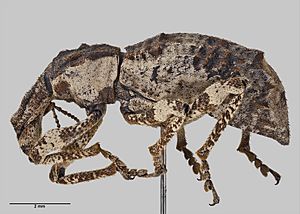Turbott's weevil facts for kids
Quick facts for kids Turbott's weevil |
|
|---|---|
 |
|
| Anagotus turbotti (Spiller, 1942) profile view of holotype specimen held at Auckland Museum licensed under CC BY 4.0 | |
| Scientific classification | |
| Kingdom: | |
| Phylum: | |
| Class: | |
| Order: | |
| Family: | |
| Subfamily: |
Cyclominae
|
| Tribe: |
Aterpini
|
| Genus: |
Anagotus
|
| Species: |
A. turbotti
|
| Binomial name | |
| Anagotus turbotti (Spiller, 1942)
|
|
| Synonyms | |
|
|
The Turbott's weevil (Anagotus turbotti) is a special type of weevil beetle. It lives only in New Zealand, which means it is endemic there. You can find this weevil on a few islands, like the Hen and Chicken Islands, the Poor Knights Islands, and the Three Kings Islands.
Contents
About the Turbott's Weevil
How it was Discovered
A New Zealand insect expert named Donald Spiller first described and named the Turbott's weevil in 1942. He studied two weevils that were found by E. G. Turbott in November 1940. These weevils were collected from the Poor Knights Islands. The weevil was named Anagotus turbotti to honor Mr. Turbott, who found them.
What it Looks Like
The Turbott's weevil is one of the biggest and most colorful weevils in New Zealand. It cannot fly. These weevils are usually between 18 and 25 millimeters long. They have bright white markings and bumpy parts called tubercles on their bodies.
Life Cycle of the Weevil
Young Turbott's weevils, called larvae, live inside trees. They are "wood borers," meaning they chew tunnels through the wood. Scientists have found them in several different types of trees. However, they are most often found living in ngaio and karaka trees.
Where it Lives
The very first Turbott's weevil that was studied came from Aorangi, an island in the Poor Knights Islands group. Besides the Poor Knights Islands, these weevils also live on the Three Kings Islands. They can also be found on Muriwhenua, which is part of the Hen and Chicken Islands. Adult weevils have been seen on Myoporum laetum and Corynocarpus laevigatus trees.
How it Behaves
Adult Turbott's weevils are active both during the day and at night. They have been seen eating the leaves of the ngaio tree.
Protecting the Turbott's Weevil
Why it's in Danger
The Turbott's weevil is easily caught by rats. This is because the weevil is large and moves very slowly. Another weevil, the Anagotus stephenensis, used to live on the mainland of New Zealand. It likely died out because of rats. The Turbott's weevil was probably found in more places in the past. Now, it only lives on islands where there are no rats or other predators.
Conservation Efforts
In September 2006, the Department of Conservation moved 30 Turbott's weevils. They took them from Muriwhenua Island to Lady Alice Island. Lady Alice Island is also in the Hen and Chicken Islands group and has no predators. This move was done to help the weevils start a new population there. To help them settle in, the weevils were placed inside special cages. These cages were in West Bay and contained the types of trees the weevils like to eat.
The Turbott's weevil is protected by law under the 1953 Wildlife Act. This means it is against the law to hunt, kill, or own a Turbott's weevil.

